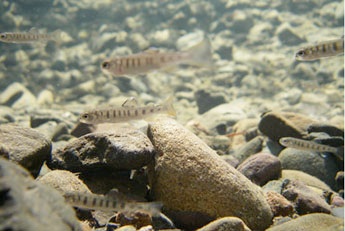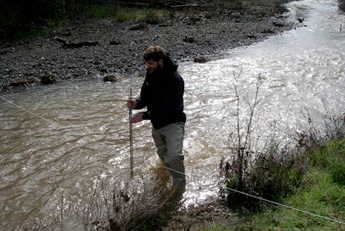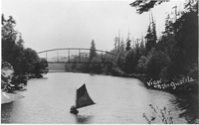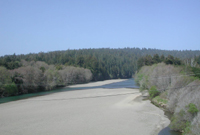GROUNDWATER CONNECTIVITY ISSUES
Court Rules the Public must be Informed about Groundwater Pumping
On August 9, 2012 Judge Grillo of the Superior Court in Alameda, Ca. granted the environmental group, Living Rivers Council (LRC), their Writ of Mandate that the State Water Resource Control Board (SWRCB) must comply with the California Environmental Quality Act, CEQA, regarding groundwater protection mitigations when applying for water diversions from streams in the North Coast. The Writ directs the SWRCB to set aside a new Policy Document, (Maintaining Instream Flows for Northern California Coastal Streams) analyze the groundwater delineations prepared for the public as protection measures for groundwater resources and disclose the ineffectiveness of existing regulations to address groundwater depletion that can be caused from diverting streams for human uses.
While the SWRCB characterizes the courts ruling as information disclosure that is ‘a small amount of information not necessary for recirculation to the public’ the Court counters with a warning to the SWRCB that under public disclosure laws it is unlikely that this information is not slight and unnecessary to inform the public. Additionally, the SWRCB tried to rely on groundwater protection mitigations to the five counties within the Policy region (Napa, Sonoma, Marin, Mendocino, and Humboldt) but only one County (Napa) has groundwater regulations. California is the only state in the western U.S.A. that does not regulate groundwater. Current SWRCB authority over groundwater applies to: 1.) permitting authority over subterranean streams 2.) the Public Trust Doctrine to protect fishing swimming and recreation 3.) enforcement authority of percolating groundwater to prevent waste, unreasonable use and method of use. The SWRCB has no permitting authority over percolating groundwater. In a state with a Mediterranean climate and increasingly frequent draughts it is unacceptable that the legislature has ignored protecting groundwater resources to date and recent attempts to do so, failed in legislative committees.
Prior to 1914 water diversions had no regulations and the wild west mentality ruled. Some said, ‘Whiskey is for drinking and water is for fighting’. After 1914 the SWRCB was developed and people wanting to divert water from streams had to file an application for a permit. However, most did not follow water laws and stole water from streams resulting in thousands of illegal and destructive water diversions throughout the State and hundreds of backlogged applications. Sadly, many streams have gone dry due too many water diversions. Currently, the SWRCB has no idea which streams have sufficient flows to allow further diversions and which streams are over appropriated. Hence Ab2121 was signed into law in 2004 by Governor Schwarzenegger ordering the SWRCB to develop principals and guidelines for the administration of water rights while protecting stream flows for fishing, swimming and recreation. A new ‘Regional Criteria’ was approved on May 4, 2010 for the administration of water rights whereby water diverters must establish water availability prior to diverting water for use such as water for grapevines (prevalent agriculture on the North Coast) stock ponds and recreation.
For over 15 years Living Rivers Council and other North Coast activists have been filing water diversion complaints and protests to conserve stream flows for fishing, swimming and recreation. Water diversions, many illegal, have devastated aquatic ecosystems throughout the North Coast bringing anadromous (salmon) fish near the brink of extinction.
The SWRCB was required to follow the California Environmental Quality Act and conduct an environmental review of the new water diversion Policy Document for the administration of water rights and to identify environmental impacts. In the review of the new Policy, the SWRCB said that water diverters could/would choose to pump groundwater (subsurface) instead of diverting water from streams (surface flows) to avoid the new scientific rigors and stream protection measures of the Policy. To further study this impact the SWRCB hired Stetson Engineers, Inc. to map groundwater impacts. Stetson Engineers determined through mapping existing groundwater depletion areas that there could be further impacts by new groundwater extraction due to the new AB2121 policy changes. In order to mitigate the pumping of groundwater Stetson developed a mitigation scheme which would require groundwater pumping setbacks from streams to protect stream flows.
Living Rivers Council filed a lawsuit asking the court for a Writ of Mandate to compel the SWRCB to recirculate the environmental documents on the new Policy and to discuss and mitigate for groundwater pumping impacts to streams.
In summary, State Superior Court Judge Grillo Alameda, Ca. granted Living Rivers Council their Writ of Mandate. The Court held that the SWRCB denied the public the right to informed self-government and abused their discretionary powers by choosing not to inform the public of the Stetson Engineer’s groundwater study and mitigations. The SWRCB must now disclose to the public the groundwater information and mapping by Stetson Engineers to provide the public the opportunity to address groundwater pumping impacts and the mitigations necessary when water diverters choose to pump groundwater.
Chris Malan, Manager of Living Rivers Council said, we need to advocate for long term recovery of California fresh water resources for all to fish, swim and recreate. Future generations count on us to keep our streams flowing.
STREAM FLOW ISSUES
This page reflects water issues that have risen to crisis levels and that need organized opposition by environmental groups and the interested public. We invite and welcome additional information for this page if you are tracking water issues and see other regional issues arising. Please contact us to share your information.
Steelhead trout lose out when water is low in wine country
Sarah Yang, Media Relations | May 7, 2012
The competition between farmers and fish for precious water in California is intensifying in wine country, suggests a new study by biologists at the University of California, Berkeley.

Juvenile steelhead trout, shown here in a small stream pool, are hit hard when water levels are low. (Ted Grantham photo)
The findings, published in the May issue of the journal Transactions of the American Fisheries Society, link higher death rates for threatened juvenile steelhead trout with low water levels in the summer and the amount of vineyard acreage upstream.
The researchers found that juvenile steelhead trout are particularly at risk during the dry summer season typical of California’s Mediterranean climate. Of the juvenile steelhead trout present in June, on average only 30 percent survived to the late summer. In years with higher rainfall and in watersheds with less vineyard land use, the survival of juvenile trout over the summer was significantly higher.
The researchers pointed out that summer stream flow has been inadequately addressed in salmon and trout conservation efforts. Previous studies have highlighted other limiting factors such as habitat degradation and water quality, but here researchers documented the importance of water quantity for restoring threatened populations.
“Nearly all of California’s salmon and trout populations are on the path to extinction and if we’re going to bring these fish back to healthy levels, we have to change the way we manage our water,” said lead author Theodore Grantham, a recent Ph.D. graduate from UC Berkeley’s Department of Environmental Science, Policy and Management (ESPM). “Water withdrawals for agricultural uses can reduce or eliminate the limited amount of habitat available to sustain these cold-water fish through the summer. I don’t suggest we get rid of vineyards, but we do need to focus our attention on water management strategies that reduce summer water use. I believe we can protect flows for fish and still have our glass of wine.”
Steelhead trout (Oncorhynchus mykiss), historically found throughout the North Pacific Ocean, are an ocean-going, or anadromous, form of rainbow trout of the salmon family. Like salmon, steelhead trout migrate from freshwater streams to the ocean before returning to their birthplace to spawn. Steelhead trout in Southern California and the upper Columbia River are endangered, and several other populations, including those in Northern California, are threatened.

Aerial view of vineyard agriculture in Sonoma County. Vineyards that divert water from streams used by juvenile salmon and steelhead trout could reduce their impacts by storing winter rainfall in small ponds such as the ones seen in this photo. (Adina Merenlender photo)
Vineyards that divert water from streams used by juvenile salmon and steelhead trout could reduce their impacts by storing winter rainfall in small ponds such as the ones seen in this photo.
While drought conditions clearly have an impact on water levels in streams, the study authors highlighted the role played by regional agriculture. Previous studies in Sonoma County have shown that stream flow drops when pumps draw water for vineyards. In addition to using water for irrigation, Grantham noted that farmers often pump water from streams to protect vines when freezing temperatures occur in the spring. Overhead sprinklers coat vines in a layer of water that quickly freezes to create a thermal barrier, preventing damage to the vines.
“Because frost threatens all of the region’s vineyards at the same time, there can be an incredible peak demand for water during a concentrated two to three days,” said Grantham, who is now a postdoctoral researcher at the Center for Watershed Sciences at UC Davis. “During a bad frost year, as much water could be used in just two weeks during the spring as in an entire season for standard irrigation needs.”
One possible solution, Grantham noted, is establishing small off-stream reservoirs to store water during times of high rainfall. Vineyards would be able to draw from these water stores during low-flow periods rather than directly from streams.
The new analysis is based upon nine years of fish count data taken from nine streams in Sonoma County, allowing researchers to account for year-to-year variability in precipitation and differences in land use.
The researchers acknowledged that there are many environmental factors that influence populations of salmon and steelhead trout, including ocean conditions, fisheries and habitat degradation, so isolating which factors are causing problems, and to what extent, is extremely difficult.

Ted Grantham is shown measuring water flows at Gill Creek in Sonoma County. (Tom Veader photo)
“This is the first scientific publication on how vineyards and summer stream flows relate to fish survivorship in California’s tributary streams,” said study principal investigator Adina Merenlender, cooperative extension specialist in ESPM. “It is the closest we have to substantiating claims by resource agencies and environmental organizations that juvenile salmon are being impacted by low flows during the summer and survive better with more flow. These findings will help inform an important environmental issue in California that is disturbing to conservationists and grape growers alike.”
Other co-authors of the study are David Newburn, now an assistant professor at the University of Maryland’s Department of Agricultural and Resource Economics, and Michael McCarthy, a research fellow at the University of Melbourne’s School of Botany.
The Environmental Protection Agency and the National Science Foundation helped support this research.
The actual study is called, “The Influences of Body Size, Habitat Quality, and Competition on the Movement and Survival of Juvenile Coho Salmon during the Early Stages of Stream Recolonization” Grantham et al_2012_TAFS.pdf (click link for study)
Irrigation rules could get tighter in Siskiyou; DFG drops appeal of ruling that enforcement is too lenient
By Ryan Sabalow
February 8, 2012
In a move that could signal more irrigation restrictions for Siskiyou County's farmers and ranchers, the Department of Fish and Game has backed away from appealing a judge's ruling that said wardens were being too lenient on those pulling water from two chronically dry coho salmon streams.
Last week the department's lawyers told a state appellate court they were dropping an appeal over San Francisco County Superior Court Judge Ernest H. Goldsmith's ruling from last year.
Goldsmith had ruled in favor of some Klamath River Indian tribes and fishing and environmental organizations that had sued the state's fisheries regulators contesting a permitting system that allowed farmers on the Scott and Shasta rivers watersheds to take irrigation water from the streams.
Goldsmith's ruling suspended the DFG's irrigation water permitting system, while the agency re-evaluated the extent irrigation is harming fish to comply with the state's environmental laws.
In their suit, environmental groups argued that the Shasta and Scott are key habitat for Klamath-run coho, which are at 2 percent of their historic numbers.
The fish have been listed as threatened by federal and state fisheries regulators.
The permitting system allowed farmers to continue to drain the streams during dry months, harming fish in the streams, the suit alleged.
The DFG appealed, arguing the permitting system, though hugely unpopular with ranchers, was a solution that struck a balance between enforcing the state's fisheries-protection laws while allowing farmers to continue to earn a living.
It's unclear what the DFG may do now.
"As far as the future, we're reviewing our options on what's next, but we look forward to improved communications with local communities, local government, tribes and conservation organizations," DFG spokeswoman Jordan Traverso said in a statement.
Traverso didn't address why the DFG backed away from the appeal.
The appeal reversal is hardly the end of the court fight over the permitting issue on Scott and Shasta.
A separate case the Siskiyou County Farm Bureau filed last year challenging whether the DFG has legal authority to issue the permits has a hearing scheduled for next week in Siskiyou County.
The farmers contend the permitting system infringes on their water rights. They argue the law the DFG was suddenly enforcing has been on the books for decades, and it's never been used to limit irrigation before.
The Department of Fish and Game's attorneys have asked that a Siskiyou County judge make a ruling. The agency's and the farm bureau's attorneys will present arguments at Tuesday's hearing in Yreka.
Russian River Flow Issues Boil Over: Groups put STATE on NOTICE of Intent to Sue to Protect endangered fish
In the aftermath of two successive years of fish kills in the Russian River watershed and the lack of effective action to protect listed species demonstrated by the agency responsible for regulating the use of water in the state, Coast Action Group, The Center for Biological Diversity and Northern California River Watch filed a 60 Day Notice of intent to sue the State Water Resources Control Board (Director Rice). Although fish kills occurred in 2008 and were predicted to occur again in the spring of 2009, and although the National Marine Fisheries Service required the State to take emergency measures to protect the protected species, the State failed to take the required actions and many fish facing extinction were killed - left stranded without adequate water. For more information you may contact Kimberly Burr or Larry Hanson at (707) 887-7433.
To read the press release written by Jeff Miller of the Center for Biological Diversity, go to the their website.
Coast Action Group recently issued a follow up comments on meetings held regarding Russian River frost protection and implications of follow up discussions, including water diverter driven solutions to problems. CAG points out flaws in arguments and data gaps that would prevent “solutions” from actually working for Russian River coho salmon. “The final (long term policy) for flow maintenance and frost protection must consider:
• The relationship of frost protection diversion issues with flow maintenance policy
• Analysis of Cumulative Watershed Effects (cumulative diversion) related to planned diversion policy - with limitations of loopholes that would subvert regulation
• Impoundment facilities that block migration and access to habitat must be removed
• By-pass flow numbers must be sufficient to support salmonids in all life stages
• Monitoring and reporting programs must be sufficient to assure success of regulations”
Meanwhile, there is a National Fish and Wildlife Foundation funded “Partnership” emerging with a group of familiar “stakeholders (http://www.cohopartnership.org/). Stay tuned. For more up information you may also contact Kimberly Burr or Larry Hansen at (707) 887-7433
Incidental Take Permits for Scott and Shasta Rivers
The California Department of Fish and Game (CDFG) proposed incidental take permit (ITP) for agricultural activities in the Shasta and Scott River basins for coho salmon under the California Endangered Species Act (CESA) will essentially turn enforcement of water law over to diverters in these Siskiyou County basins despite the fact that subsequent actions will not likely recover coho salmon. These severely flawed ITPs will instead cause coho salmon to go extinct and plans do not include protection of other Pacific salmon species that are currently at risk.
Action Alert! On September 22, 2009 CDFG accepted as final the Environmental Impact Reports (EIRs) for ITPs for Shasta and Scott Rivers. Earth Justice filed a lawsuit on grounds of insufficiency under the California Environmental Quality Act (CEQA) on behalf of Klamath Riverkeeper, the Quartz Valley Indian Reservation, Environmental Protection Information Center (EPIC), Northcoast Environmental Center (NEC), Sierra Club, Pacific Coast Federation of Fishermen’s Associations and the Institute for Fisheries Resources. (Read press release)
CDFG Director Donald Koch stepped down the day before the ITP lawsuit was filed and some see a tie with our ITP challenge, since Don was elevated from CDFG Region 1 and the template applied in the Shasta and Scott were thought likely to be expanded to the rest of the State. Meanwhile, fall rains were sufficient to move fish up into the Shasta and Scott Rivers and cooler temperatures have alleviated chances for a large fish kill, low flows persist in the Scott River. Field reconnaissance on the first few days of November showed that a very large run of Chinook salmon is in the Scott River canyon but unable to access upstream reaches because agricultural operations are impeding flows (Read related story)
Contact or support the organizations launching the ITP challenge in court. Let your elected officials and CDFG upper management know of your displeasure regarding the environmental and social injustice this represents.
Read about current Scott River flows and salmon runs.
Critiques of Shasta and Scott Draft ITPs by Quartz Valley Indian Community on behalf of Klamath Basin Tribal Water Quality Work Group
Shasta Draft ITP 2006
Shasta Draft ITP 2008
Scott Draft ITP 2006
Scott Draft ITP 2008
Final Scott River ITP Volume #1
Final Scott River ITP Volume #2
Final Shasta River ITP Volume #1
Final Shasta River ITP Volume #2
For more information or hard copies call:
Caitlin Bean, Staff Environmental Scientist
California Department of Fish and Game
Northern Region
601 Locust Street
Redding, CA 96001
Office: 530-225-2273
Fax: 530-225-2381
North Coast Instream Flow Study
The State Water Resources Control Board (SWRCB) Water Rights Division (WRD) published the Draft Policy for Maintaining Instream Flows in Northern California Streams in December 2007. The study was prompted by AB 2121, a bill passed in 2004 to prompt action on getting flows back in northwestern California rivers (read history of AB 2121). Peer reviewers hired by the SWRCB found that their approach to allocating “surplus” winter water was infeasible unless flow data were collected in watersheds throughout the region.
Read a summary critique of the proposed policy.
Read comments submitted to SWRCB regarding the proposed policy:
Band, L.E. 2008. Review of the Scientific Basis for the Proposed “North Coast In-Stream Flow Policy.” Prepared for the CA SWRCB WRD. University of North Carolina, Chapel Hill, NC. 12 p.
Gearhart, R. 2008. Review of Draft Policy for Maintaining In stream Flows in Northern California Coastal Streams. Prepared for the CA SWRCB WRD. Humboldt State University, Environmental Engineering Department, Arcata, CA. 7 p.
Higgins, P.T. 2008. Comments on Draft Policy for Maintaining Instream Flows in Northern California Coastal Streams. April 2, 2008. Prepared for the Redwood Chapter of the Sierra Club by Patrick Higgins, Consulting Fisheries Biologist, Arcata, CA. 49 p..
McMahon, T. 2008. Review of “Draft Policy for Maintaining Instream Flows in Northern California Coastal Streams.” Prepared for the CA SWRCB WRD. Professor of Fisheries, Montana State University, Bozeman, MT. 11 p.
Vicki Whitney who heads the SWRCB WRD told activists that they plan to move forward on policy implementation without first collecting new data. Actions may include giving a blanket amnesty for illegal impoundments smaller than 10 acre feet. This must be opposed. Stay tuned!


